Aucassin in Nicolette, illustrated by Anne Anderson
The Story of Aucassin in Nicolette with pictures by Anne Anderson
Aucassin in Nicolette is a so-called chantefable or Song-Story, a combination of verse and prose, similar to prosimetrum. It's a unique example of the genre, made of then well-established Arthurian romance and tale in verses.
There's only one surviving manuscript of the story about Aucassin and Nicolette, written by an unknown author in the late 12th or the 13th century which is now archived in France's Bibliotheque Nationale. It was discovered in 1752 by Jean-Baptiste de La Curne de Sainte-Palaye (1697-1781), a classicist, historian, medievalist, lexicographer, and philologist.

"Aucassin and Nicolette" was very likely made as a base for acting which is supported by the quality of the part in prose (which doesn't stylistically offer much) and poetic part (where the anonymous author showed not only good rhetoric skills but used some original approaches in metrics as well). Yet, our intention is not to dive too deeply into this text.
Let's go to the summary of the story, supported by Anne Anderson's pictures from times when her name already became popular although her talent fully shined a full decade later.
A short summary of Aucassin in Nicolette
The story starts with a prelude in verse. The setting is very similar to the numerous settings of the stories from the same period. Count Garin of Beaucaire is at war with Count Bougars de Valence. His son Aucassin doesn't want to help him fight the enemy because he is so obsessed with love.

His love is Nicolette, a young slave of Saracene origin, who was bought, baptized, and raised as his own daughter by the Captain of the city. Aucassin's father decided to put the son's distraction away by ordering the Captain to get rid of Nicolette by sending her away.
But Captain decided to imprison Nicolette in a tower where an old lady kept her company. Countless rumors spread across the country claiming that Nicolette died, traveled far away, or married somebody abroad, and so on and on. Aucassin still didn't care about his father's war. So Count Garin promised him a chance to see his love if he goes into a fight.

Aucassin didn't achieve much on the battlefield because his mind was still occupied with Nicolette. Only when he realized he won't see her if he dies, starts fighting. He was so fierce he killed and wounded many knights from the opposing party. Even more, he managed to imprison the leader, Count Bougars.
When his father didn't keep his part of the deal, denying the chance of meeting with Nicolette, Aucassin released Count Bougars. Count Garin was furious with the treachery of his own blood, so he imprisoned Aucassin.
In the meantime, Nicolette escaped from her prison by making a robe of linen and went after Aucassin.

She get to the castle with the dungeon, where he was imprisoned but couldn't get in. The guards who believed she would be somewhere near her love were looking for her and she decided to hide in the wood where she made herself a shelter.

Some time later Aucassin was taken out of prison to participate in some feast and a friend gave him a horse so he could escape. He looked for Nicolette and made his way to her shelter when she was not there.

But she returned and the couple was finally united.
They decided to leave the country by ship. A storm brought the ship with the lovers to a strange place called Torelore. For some time they lived there until Saracens attacked the castle and capture everybody. Aucassin and Nicolette were separated again.
His ship was destroyed by another storm and he returned to his home finding that his parents are dead and he became Count of Beaucaire.
Nicolette was boarded on another ship and went to Carthage. When she saw the city, she remembered her childhood. She was the daughter of the king who was very happy to see her again and immediately offered her a marriage with one of the local kings.
Yet Nicolette stayed faithful to Aucassin. She disguised herself as a minstrel, boarded one more ship, and returned to Provence singing from castle to castle until the new Count of Beaucaire heard her songs depicting her adventures in search of love with him.

They are reunited and stay together for good.
What is so special about Aucassin and Nicolette?
The story is a parody of virtually every existing literary genre in France in the 12th and 13th centuries: courtly novels, heroic poems, lyric poems, saint's life fables, etc. It exploits the existing overused patterns in reverse ways to achieve maximal although soon predictable humorous effect.
Here are a few examples:
- Aucassin's name sounds way more like the name of Saracen than Nicolette's whose name is typical Christian.
- She is extremely resourceful and he is confused as a stereotypical lady in distress.
- In Torelore there's a pregnant king and it's a queen who is leading the army.
- The Lady is seeking the man, going through numerous dangers, climbing the walls, etc.
It seems, like Andrew Lang smartly concludes in one of his texts, the author of Aucassin and Nicolette made the only serious part of the story the love of the protagonists and even this part is not very serious. Enjoy this classic piece of literature!
You are also cordially invited to learn more about Anne Anderson's life and work.
Pentamerone
The Pentamerone, or The Story of the Stories by Giambattista Basile
The Story of the Stories (or sometimes The Tale of the Tales) is officially the first collection of fairy tales presenting several plots from popular fairy tales like Rapunzel, Sleeping Beauty, Cinderella, The Goose Girl, and others in rougher, often even vulgar versions.

They were written centuries before today's more known variations, often being presented in a printed form for the first time.
In a way, we can say The Pentamerone, as The Story of the Stories is best known today, is a grandmother of modern fairy tales.

This beautiful hand-colored illustration by legendary George Cruikshank presents one of the scenes from just one of the fifty fairy tales in the book. We'll shortly present it through a heavily censored translation by John Edward Taylor. The first English translation in 1847 presented only 30 stories. Reprints were further censored and sanitized, or, as we can poetically say 'revised and edited' which led to only 19 tales (plus the frame story, of course) in the version we are presenting today. It was edited by Helen Zimmern and published in 1893 by Cassell Publishing Company in New York.

(Minecco Aniello before the king Nibbler)
The illustration above is much closer to George Cruikshank's original. The illustrator was already dead for a decade and a half at the time of publishing. Other illustrations will be of similar or even lower quality, what is considering the time of print (chromolithography was fully developed) a sure sign of trying to maximize the publisher's profit in the already very competitive market. Yet we can still enjoy the presentation of this fascinating book.

The book starts with a preface, where we find out a bit about the author, the original dialect, and the translation and adaptation of the text.

A list of stories follows. Only 20 out of 50 are included in this book.

After that, a list of illustrations by George Cruikshank is presented. There are 10 illustrations altogether. We'll see each one of them as it was included in the book.

Introduction

We are introduced to Princess Zoza who can't laugh. Her father solved the problem but this led to the curse - she has to fill a jug with her tears in just three days. She is tricked by her slave, who stoles her identity and marries the prince. Her pregnancy is the reason for the storytelling marathon, but also the disclosure of her con.
Peruonto

Peruonto is a foolish but nice boy who is rewarded by fairies with a special gift: all his wishes will become true. This way a princess falls in love with him. Her father was mad at her and tries to punish her, but in the end, everything pans out well and Peruonto becomes the smart, handsome husband of the princess and the heir to the throne.

Vardiello


The flea


The enchanted doe

Also known as The Enchanted Dove the story presents two brothers, the twins who loved each mother so much their own mother became jealous. So one of them left the other, married a princess, but after some time became a victim of shapeshifting ogre, who tricked him into appearing as a dove.
Thanks to the magic brook and a myrtle his brother noticed his trouble soon enough to save him.
Parsley

One of the oldest versions of Rapunzel.

The three sisters

A story about a good and two bad sisters. The bad ones try to destroy their sister's luck but are punished for their wickedness in the end.

Violet

Gagliuso

Sometimes titled Cagliuso or Pippo it's a variant of today's much more known Puss in Boots.
The serpent

This story belongs to the family of so-called animal groom fairy tales and bears a lot of resemblance with East of the Sun, and West of the Moon.
The she-bear

We are dealing with one of the sub-families of Cinderella stories. The main plot is simple, although a bit dramatic for today's audience: father falls in love with his own daughter!

The dove

It's a fairy tale about a prince who is cursed and falls in love with a daughter of the ogress. He has to solve three impossible tasks and is cursed again, but everything ends happily.
The booby


The stone in the cock's head

The two cakes

An old version of Diamonds and Toads.

There are several elements of the Goose Girl in this tale as well.

The seven doves

As we can suspect from the title, it's a variant of Seven Ravens.

The golden root

It's a variant of the myth about Cupid and Psyche, which puts this tale in the category of East of The Sun and West of the Moon and The Beauty and the Beast category.

Nennillo and Nennella

We are dealing with an old version of Brother and sister.

The three citrons

It's a tale about a stolen identity with recognizable elements of several classic fairy tales.
Conclusion

Here the story about Zoza from the beginning comes to a satisfying conclusion. The treacherous slave is revealed and punished. Zoza gets her prince and the book of Pentamerone comes to the end.
This is all about today's book, The Pentamerone, The Story of the Stories, printed by R & R Clark.
Beauty and the Beast as Presented in Home Pantomime Toy Books
Beauty and the Beast by Richard Andre
Beauty and the Beast is among the most recognizable fairy tales in the world. Immortal story by Madame Leprince Beaumont (being a rewriting itself) went through numerous adaptations aiming at a very different audience. This post presents one of the so-called toy books, an innovation of the 19th century, where the pages could be moved and folded in different ways to present a 3D effect or change of scenes.

Richard Andre, one of the most prolific illustrators of his time, made a step further. The story about the pretty and kind girl who is willing to sacrifice her life for her father, and the enchanted prince who needs to find true love before he can break a spell by which he became The Beast, was adapted for the theatre.
It's a pantomime theatre, where the movement speaks instead of words but the scenery has a tremendously important role as well. We don't know for sure who contributed to the final product because credits and copyrights were not particularly taken care of in those times. Richard Andre, who changed his name two times, just to escape the sins from his past, probably didn't care much about that either.
Anyway, we are dealing with a characteristic product from the newly developed field of picture books - a pantomime toy book. The printing technique was chromolithography, done by Emrik & Binger, published by Dean & Son, London, in 1880.

The play obviously starts with the departure of the father. While the Leprince Beaumont's story informs us about the merchant, his business, the relationships in the story, and the crisis leading to the relocation of the family from town to much smaller country house, all this information is supposed to be already known or irrelevant to the story. The setting is Oriental, which gives an additional exotic feel.

Merchant's travel is not a nice one. He looks worried, the trees are threatening. Everything can happen.

We don't know what happened to the camel but the merchant is not ready to give up yet. It looks he'll continue on his foot.

And there it is - a magnificent palace, looking like a perfect shelter to the man who was so troubled. Things look much more optimistic now. Now threatening trees around!

Merchant's luck is coming back - he found a rose, a flower he promised to his youngest daughter. Yes, Beauty will be very happy when she receives it.

But that was a mistake. A fatal mistake. Roses are not meant to be picked. They are beautiful just like they are - alive, on the bush, with other roses. The Beast demands punishment. Will the merchant pay with his life? Or can he offer something better?

Beauty feels guilty. Her wish for the rose led her father into trouble. She is willing to replace him in front of the Beast. She demands that.

The first meeting between Beauty and the Beast is surprisingly nice. The Beast doesn't intend to eat her or tear her apart. At least for now. He even brings her flowers. They soon befriend each other.

But Beauty's life in the palace has its downsides. She misses her father. A magic mirror shows her his image which worries her even more. Merchant is ill. Very ill. Beauty wants to see him. The Beast gives her permission to visit her family but she must return soon. Otherwise, he will become ill.

Beauty kept her word and returned to the palace. Just about time to find the Beast on the floor. Her father is better but her friend is in trouble now. Will he die? She realizes how important it became the Beast to her. She wants to stay with him forever. She would like to marry him.

The Beast heard the good news. His health is restoring. The presence of Beauty is the best medicine for him. Soon he transforms into a handsome prince. He was enchanted and only true love could save him.

A marriage between Beauty and the Beast follows. Her jealous sisters are there too. But they are transformed into the statues. This way they can't hut the happy couple anymore. Magic works in their favor now. Her father moved into the palace as well.

This book is just one of the series. If I find another one, I'll add it to this blog. In the meantime, you can check an interesting article about the mythology behind the fairy tale about Beauty and the Beast!
Calendar for 1896 by Eugene Grasset
Eugene Grasset was one of the most successful artist on the edge of the 19th and the 20th centry. This calendar is just one example of his skills.

Eugene Samuel Grasset was born on May 25th, 1845, in Lausanne, Switzerland. He showed great talent for drawing from the early years, learning to use chisel and gauge from his father, who was a successful sculptor and cabinet maker. His first mentor was Francois-Louis David Bocion at Ecole Industrielle in Lausanne, where he studied for two years.
Eugene left for architecture and later sculpture studies in Zurich, following the steps of his father. While he never worked as an architect, his sense of proportions and symmetry absolutely benefited from the studies. After his graduation whole family took a trip to Egypt what influenced Eugene who soon became interested in Egyptian and Japanese art. These influences stayed part of his creative process for the rest of his life.
For a couple of years, he worked as a painter in Lusanne. In 1871 he moved to Paris, in many ways the art capital of the world in those times. There he established his career as a designer of fabrics, furniture, and jewelry. Industrial design occupied him for several years, leading to his work in the area of ceramics and stained glass, combining very different materials and building his time as one of the best designers in Europe.
He earned money by decorating homes of affluent families, churches, libraries, and other public buildings with mosaics and stained glass, combined with ivory, silver, gold, and precious stones. He also taught at Ecole Guerin, Ecole d'Art Graphique, Academie de la Grande Chaumiere, and Ecole Estienne. Several of his students later became successful artists as well. We should also mention illustrations for the books Le Petit Nab in 1877 and Histoire de quatre fils Aymon 1883.
Let's take a look on the rest of his calendar for 1886:












In the 1890s he started designing posters, a relatively new and unexplored media if we consider the innovations in printing. Grasset was a jack of all trades, being able to create a complete poster, from typography (he created his own fonts) and tiniest ornaments to final composition with the message. He also created magazine covers, logotypes, carpet patterns, stamps, calendars... His biggest influences were Gustave Dore (in the illustration) and Eugene Viollet-le-Duc (in the industrial design).
Eugene Grasset is one of the most influential artists from the Belle Epoque and a pioneer of the Art Nouveau era. His variety and skills can be compared with another, although much more widely recognized artist - Walter Crane.
Grasset's probably most recognizable characteristic was the ability to decorate any object without suffocating the leading motif, what was exactly what the poster art needed - staying simple, focused to the point, yet pretty and even attractive for spectator's eyes. His style was so recognizable and effective, Americans invited him to design some posters for them as well (Christmas issue for Harper's Bazaar in 1892, for instance).
He exhibited at Salon des Cent in 1894 and Salon des Artistes Decorateurs in 1904. The greatest hit was the presentation of his font named Grasset, engraved by G. Peignot et fils at the Universal Exposition in 1900. Did you know he even published a dissertation about the usage of plants in design? He was also one of the inventors in the field of printing color photos.
Grasset died on October, 23th, 1917, in Sceaux, today's suburbs of Paris, France. The presented calendar was made for 1886 but it will be 100% accurate in 2030 again!
The Piper of Hamelin - A Fantastic Opera in Two Acts by Robert Buchanan illustrated by Hugh Thomson
Most children today never heard about the Pied Piper of Hamelin. The story about the piper who saved the city of rats and, because he wasn't paid as expected, led all the kids out of town, is just too scary. A century ago publishers of books for children didn't care so much of the possibility of hurting sensible kids' souls. But even then some people believed this should be a different kind of story. Not so eerie, with a happy ending, if possible.

One of them was obviously Robert Williams Buchanan (1841-1901), a dramatist, a poet, and a writer from Scotland. He wrote the play about the mysterious disappearance of children in Hamelin in 1893 when he was already an established writer and dramatist. The book was published in the Comedy Theatre collection by William Heinemann in London.

The play is written in two acts. The author mentions on the first page it follows the plot of the original legend in the first act but it's completely original in the second. Well, there's a significant difference in the first act already. The focus of the conflict is not on the Piper against the citizens but the Piper against the Mayor. The Mayor, who is presented just as a representative of all citizens of Hamelin in Browning's version, is not particularly popular among his own people.
There is also an introduction of a positive character named Conrad in this first act. Conrad agrees with Piper about the payment. He even offers to pay a part of the owed money instead of the Mayor. Unfortunately, he is pretty poor, so he can't possibly match the agreed sum. He is also in love with the Mayor's daughter Liza, what puts him in a conflict situation - a major building block of any drama, even if it's made for kids.

The second act is truly Robert Buchanan's original product. Let's cruise through the illustrations signed by Hugh Thomson (1860-1920) and try to follow the whole story.
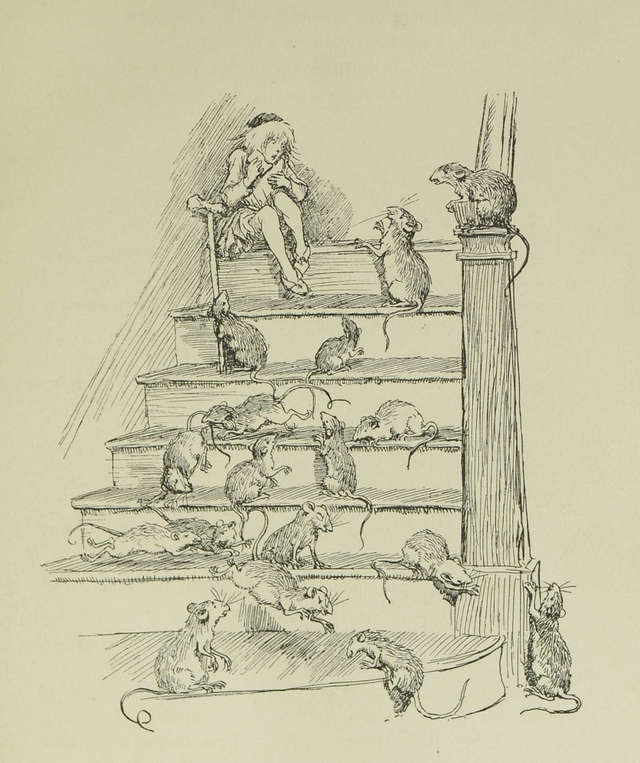
The town of Hamelin was infested with rats. They were everywhere and nobody knew how to get rid of them.

People were afraid of these tiny little beasts. The quality of life in the city was rapidly falling.

The town council had meetings but nobody proposed any useful solution. They had a rat-catcher before, but the Mayor dismissed him to save some money. Now the rat infection threatens to destroy the trade and other profitable activities in the city. People blame the Mayor for the situation. He should find a solution as soon as possible. He was forced to offer a thousand guilders to the one who rids the town of the rats.

Another Mayor's worry is an introduction to Conrad. He is a pauper, a poor young man who loves his daughter Liza. And Liza Loves Conrad as well. Mayor doesn't want Conrad around his daughter so he tells him to go away. But will the youngster listen to him?
Then the Piper appears in front of him. He said he can save the city. He can transform the rats into a distant memory in a matter of a few hours. Of course, he expects payment for his efforts. The Mayor tells him about the offer of one thousand guilders. Can the Piper release at least some tension from the Mayor?

When the Piper starts playing rats came from all the places they were hiding. They followed the song wherever the Piper goes.
He went through the city until all the rats were lined after him. Then he led them into the river where they drowned.
But when the Mayor found out there are no rats anymore, he didn't want to part the guilders.
Piper demands the payment for his service. Mayor doesn't want to pay.
Piper starts losing his temper. Conrad offers to pay at least some of the mayor's debt.
But the Piper insists on one thousand guilders. If not, something very bad will happen. Something to the kids.
Mayor starts threatening him. Piper must leave the city.

But he returns. And he has his pipe with him.
When the Piper starts playing again, all children under 14 years fall into a trans-like state. The music is inviting. They must follow.

All children of the town of Hamelin go after the Piper. Nothing can stop them.

Parents are trying to dissuade the Piper from his plans. All their attempts are futile.

The Piper leads the kids in the mountains, higher and higher until they are all lost in the caves.
The people of Hamelin go after him but they don't have the power to get their children back. They are still hoping the Piper changes his mind.
Then he proposes another deal. He will return the children if one of the young women from Hamelin becomes his wife.
Some of them are actually willing to sacrifice, but he wants young, pretty, and in household chores skillful lady.
In short - he wants Liza, the Mayor's daughter.
And he wants a dowry with his bride - exactly one thousand guilders!
The Mayor is horrified. Conrad is devastated.
Liza is not particularly happy either. Yet, after a while, she is willing to become Piper's wife if he releases all the children. Her life for hundreds of others.
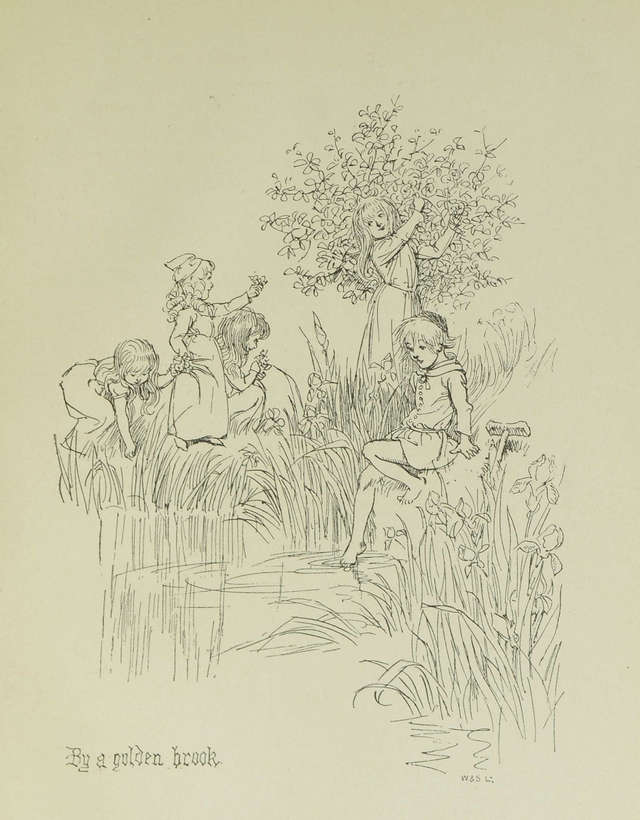
The kids are waiting for the final result of the negotiations safely playing in the neighborhood, hidden from the eyes of their parents.
When everybody agrees on Piper's terms, the thousand guilders are brought by the Mayor, and Liza is ready to be married, the Piper serves his final surprise to the audience. He will not marry Liza. Conrad can get her for wife and the money will go to them to start their mutual life in comfort.
He releases the children.
Everybody (but the Mayor and the rats) is satisfied.

So the story instead of criticizing the hypocrisy of the citizens focuses on one bad character who needs to be thought a lesson. If you want to know more about the background of the legend about the Piper of Hamelin and it's presumably true background, go to:
All illustrations are done in pen and ink by Hugh Thomson, an Irish illustrator who illustrated numerous works including ones by Jane Austen, James Matthew Barrie, Charles Dickens, George Elliot, Elizabeth Gaskell, Oliver Goldsmith, and William Shakespeare. He was known by his ability to project himself in the story and especially praised for his work on Austen's and Barrie's novels. He preferred black and white illustrations and colored his pictures only if a published specifically demanded that.
Old Ben by James Otis and Sarah Noble Ives
Old Ben is the third and last one in the trilogy of the stories about Toby Tyler. The full title of the book is Old Ben, the friend of Toby Tyler and Mr. Stubbs Brother.
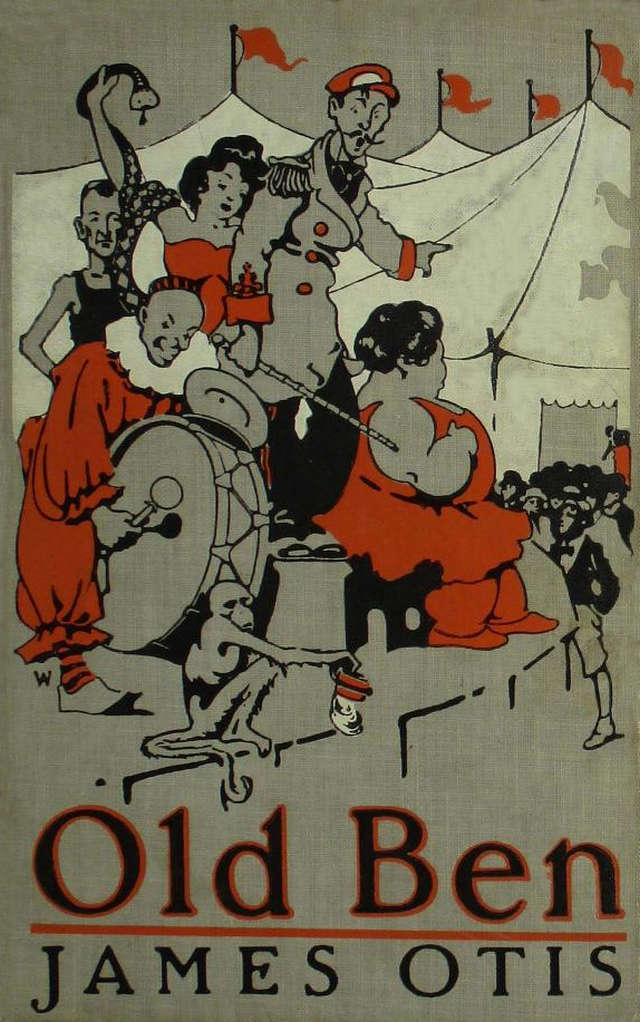
The first book in the series, Toby Tyler, or, Ten Weeks with Circus, also the first book written by James Otis Kaler, became the most popular among his numerous works and the reason is simple - Walt Disney Productions made a movie, based on it, in 1960. In the story, we meet an orphan boy who would like to work in the circus. But when his wish comes true, he soon realizes how harsh may be the reality of the circus. There is also a cute chimpanzee and a bad guy who lies about real feelings of Toby's uncle and aunt. Eventually, he leaves the circus.
In Uncle Ben, we start with the scene where the very same circus comes to the town where Toby lives. The dream about circus glamour is still there. The chimpanzee too. Is now the right time to fulfill his wish?
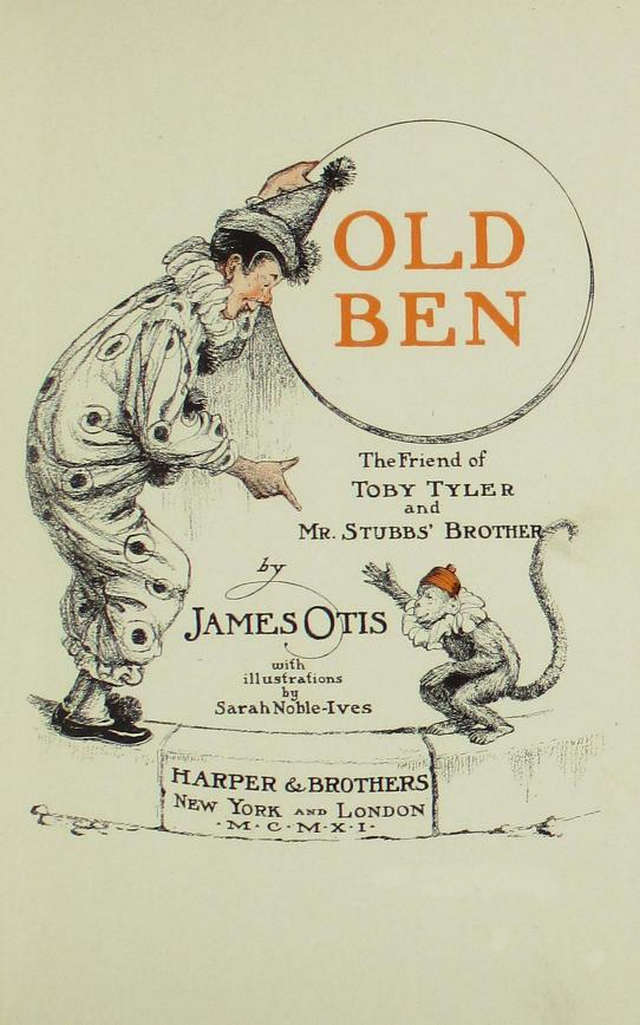
The author of the book started his writing carer as a journalist (he reported from the American Civil War, for instance). This probably at least partly explains his enormous production. He signed about two hundred books altogether. Considering the fact, he wrote under pen names Walter Morris, Lt. James K. Orton, Harry Prentice, and Amy Prentice (with assumption some of his later works were actually written or co-written by his wife), we'll never know what really belongs to his opus. Among other books, he wrote a series of boy spies (10 books), a series of navy boys (7 books), a series of historical novels (about 50 titles), a farm series (4 titles), a school series (3 books), a series about New York (7 titles) ... He also signed at least six nonfiction books.
So Toby trilogy is actually one of his minor projects!
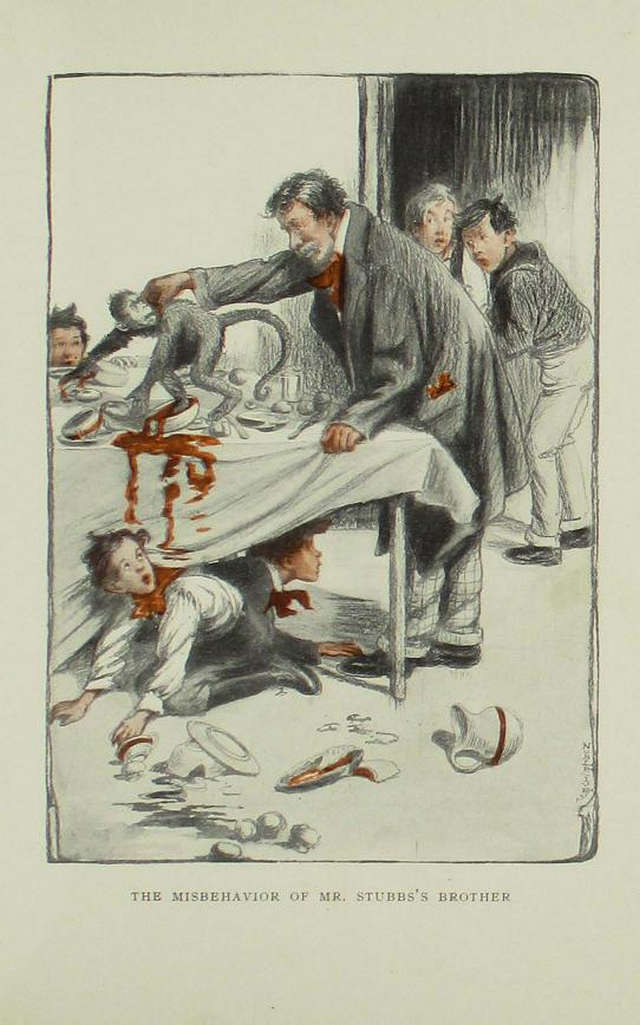
The misbehavior of Mr. Stubbs's brother

The Serenade

Mr. Treat proceeded to the honors
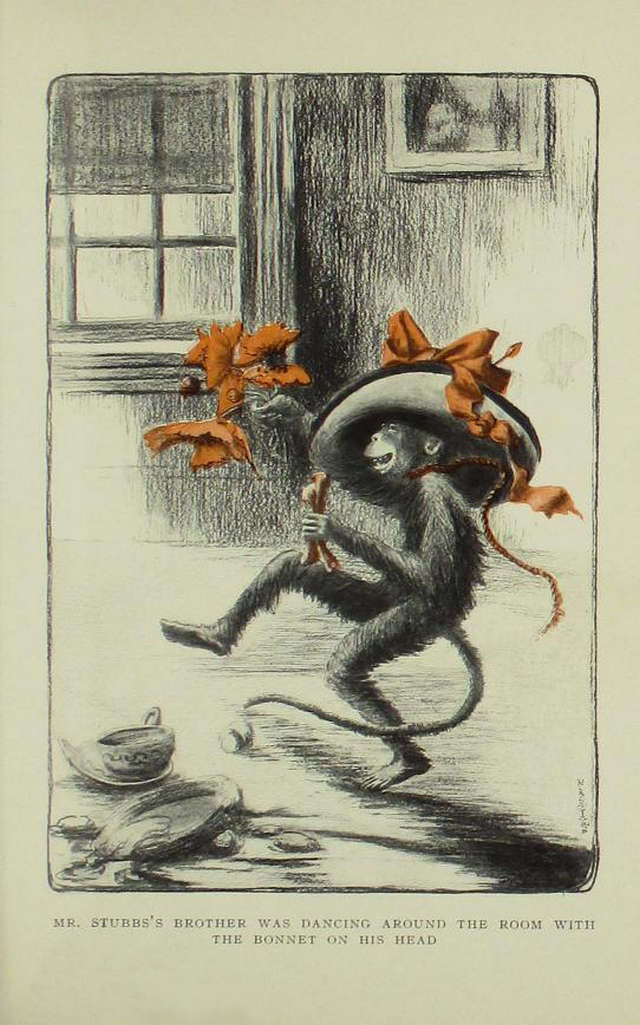
Mr. Stubbs brother was dancing around the room with the bonnet on his head
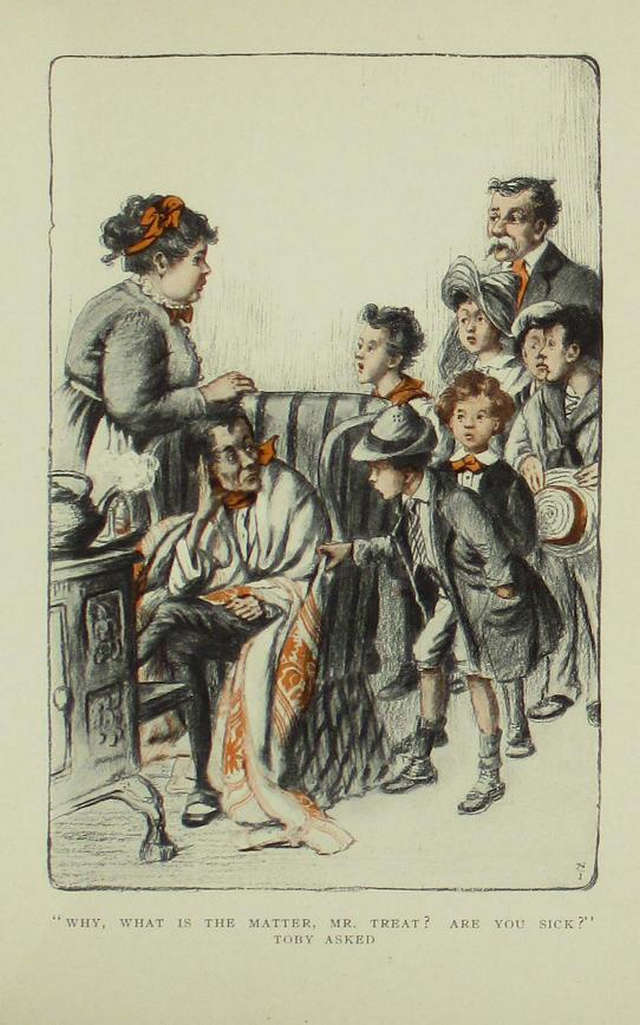
"Why, what is the matter, Mr. Treat? Are you sick?" Toby asked
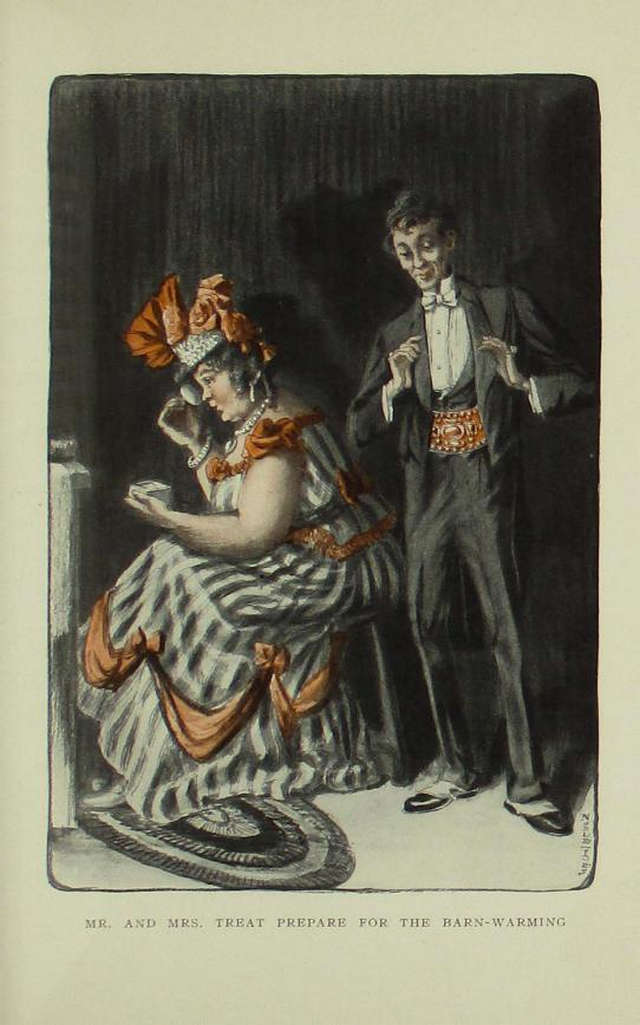
Mr. and Mrs. Treat prepare for the barn-warming
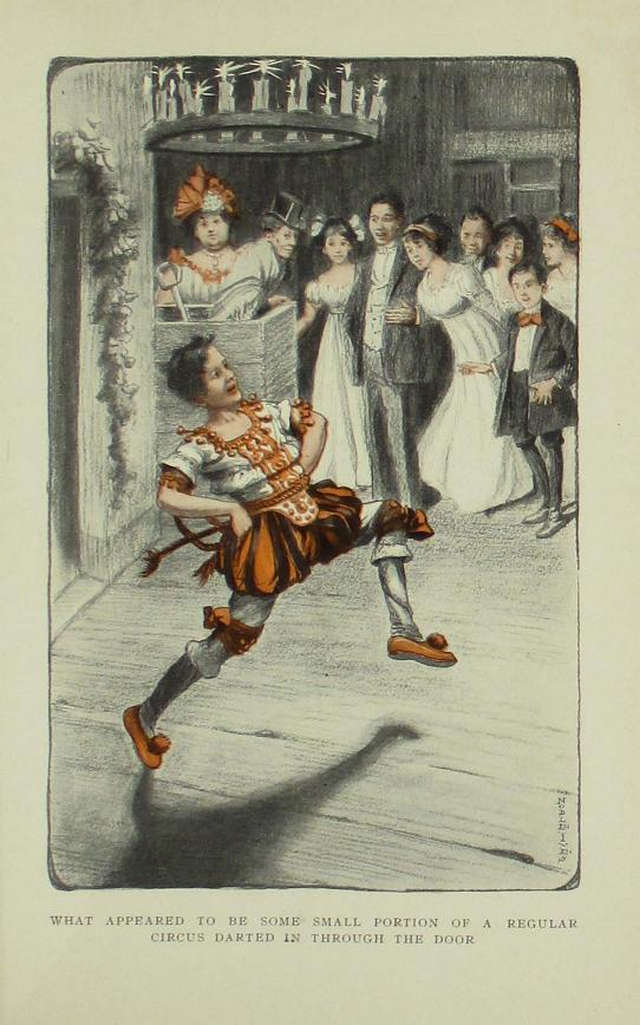
What appeared to be some small portion of a regular circus darted in through the door
Sarah (Sara) Noble Ives illustrated the book with seven original color pictures plus cover and the inside title page. When we say color, we should be aware of often limited technical an financial possibilities of color printing, what in this specific case means there is only one color (orange-red) added to black and white line drawings. Despite that Noble Ives managed to create a warm and charming atmosphere of typical boys' adventure environment which still can't leave cold any true lover of vintage books. This edition was published by Harper & Brothers, New York in 1911. Occasionally, it's still available through the web for about 30 USD. If you got one in good condition, it may prove a pretty good investment.
The Ant and the Grasshopper: What's the Real Moral of the Story?
The famous fable about the ant and the grasshopper is worldwide known for many centuries. It's moral is clear and ruthless. You should use the good times to prepare for bad times. Because bad things will happen.
The grasshopper doesn't care about the future. He sings and enjoys through the whole summer while the ant works, works, and works. When the winter comes, the ant has loads of stock. The grasshopper has nothing. In the grand finale of the story the grasshopper asks for some help and the ant denies it. No, everybody who didn't work should not eat either.
This dramatic, in many ways even tragic situation inspired numerous artists in history. Let's see how some famous painters and illustrators saw it.

Oliver Herford portrayed the meeting of both characters before the crisis occurs. The grasshopper is happy and the ant looks very tired. In this very moment, the roles of the winner and the looser look very different.

Ernest Griset focused on ants. Yes, plural. It somehow looks different if we have a community of ants and an outsider like the grasshopper. Their collective decision of helping or not helping the poor musician is distributed among all the members. Each one of ants can think for himself he would help but the majority decided differently. Long live democracy!

Charles Henry Bennet decided for the scene of begging. Look how weak and powerless looks the grasshopper. Compare the position of his neck with the position of the ant who is strong, determined and merciless. Cruel as nature can be. But aren't we, humans, better than the basic players of the eternal game of survival?

La Fontaine already understood Aesop's fable about the ant and the grasshopper differently. He rewrote it (like hundreds of others) and put it in verse. He also changed the title. The grasshopper became the cicada - which emphasizes the musicality of the insect. With that simple change, a whole new debate about the importance of culture opens. Do we need people who are so 'unproductive' as artists? Who's responsibility are artists when they fall into trouble?
The other change of the title is seemingly less important, yet maybe even more crucial. It's the order of the main characters: The Cicada and the Ant and not The Ant and the Grasshopper anymore. The artist is in the first place now.
French illustrators loved the theme. Especially when they worked on La Fontaine's version.

Gustave Dore decided to portray people instead of insects. This way the message of the picture becomes crystal clear. We have a lady with a musical instrument in an obviously submissive position and a wealthy lady with kids who, it looks like, just opened the door. Her kids look favorably at the musician, but their mother stays distant and exalted. Dore even made an allusion on 'les tricoteuses', women who were knitting while waiting on executions at guillotines during the French Revolution.

Jehan Georges Vibert took a similar approach with people instead of insects. His characters represent two social classes. There's a catch - who is working harder? The monk, who collects the contributions or the musician who plays for whatever his audience gives? Note how skillfully the painter used the musician's instrument and monk's basket to mimick grasshoppers abdomen and ant's antlers.
It looks the more we look at the fable, more questions pop up. This is a sure sign of true artistic work. We'll definitely have to return - with more pictures and more questions about the moral in the story about the ant and the grasshopper.